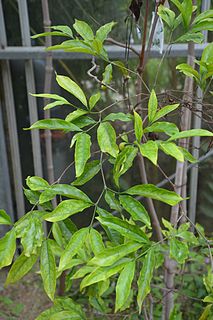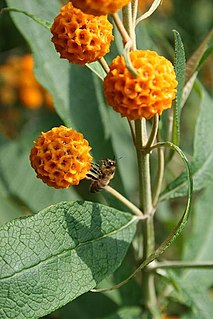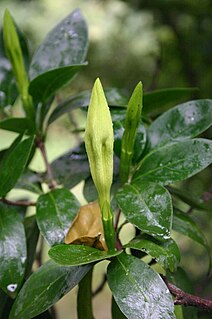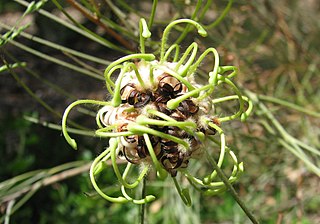
The Rubiaceae are a family of flowering plants, commonly known as the coffee, madder, or bedstraw family. It consists of terrestrial trees, shrubs, lianas, or herbs that are recognizable by simple, opposite leaves with interpetiolar stipules and sympetalous actinomorphic flowers. The family contains about 13,500 species in about 620 genera, which makes it the fourth-largest angiosperm family. Rubiaceae has a cosmopolitan distribution; however, the largest species diversity is concentrated in the tropics and subtropics. Economically important species include Coffea, the source of coffee, Cinchona, the source of the antimalarial alkaloid quinine, some dye plants, and ornamental cultivars.

The chlorarachniophytes are a small group of exclusively marine algae widely distributed in tropical and temperate waters. They are typically mixotrophic, ingesting bacteria and smaller protists as well as conducting photosynthesis. Normally they have the form of small amoebae, with branching cytoplasmic extensions that capture prey and connect the cells together, forming a net. They may also form flagellate zoospores, which characteristically have a single subapical flagellum that spirals backwards around the cell body, and walled coccoid cells.

Cryptomeria is a monotypic genus of conifer in the cypress family Cupressaceae, formerly belonging to the family Taxodiaceae. It includes only one species, Cryptomeria japonica. It used to be considered by some to be endemic to Japan, where it is known as Sugi. The tree is called Japanese cedar or Japanese redwood in English. It has been extensively introduced and cultivated for wood production on the Azores.

The blue spruce, also commonly known as green spruce, white spruce, Colorado spruce, or Colorado blue spruce, is a species of spruce tree. It is native to North America, and is found in growing zones 1 through 7. Its natural range extends from northern New Mexico through Colorado and Utah to Wyoming and into Alberta and British Columbia, but it has been widely introduced elsewhere and is used as an ornamental tree in many places far beyond its native range. The blue spruce has blue-green coloured needles and is a coniferous tree.

Endiandra is a genus of approximately 100 species of plants, mainly trees, in the laurel family Lauraceae. They are commonly called "walnut" despite not being related to the Northern Hemisphere walnuts which are in the family Juglandaceae.
The elm cultivar Ulmus 'Globosa' was first described in the Späth nursery catalogue of 1892–93. Considered "probably Ulmus carpinifolia " by Green
Aristeguietia glutinosa is a species of flowering plant in the family Asteraceae. It is found only in Ecuador, where it is commonly called matico. In Peru, that name refers to the unrelated Piper aduncum, in Chile and Argentina the name matico is used for Buddleja globosa.
Anisophyllea globosa is a tree of Borneo in the family Anisophylleaceae. The specific epithet globosa is from the Latin meaning "round", referring to the fruits.

Rothmannia annae is a species of plant in the family Rubiaceae. It is endemic to the Seychelles. It is found in its natural state only on Aride Island, where its habitat is protected by Island Conservation Society.

Rothmannia is a genus of flowering plants in the family Rubiaceae. It was described in 1776 and is named for Göran Rothman (1739–1778) by Thunberg – both were pupils of Linnaeus.
Rothmannia ebamutensis is a species of plant in the family Rubiaceae. It is endemic to Cameroon. Its natural habitats are subtropical or tropical moist lowland forests and subtropical or tropical moist montane forests. It is threatened by habitat loss.
Symplocos globosa is a species of plant in the family Symplocaceae. It is endemic to Ecuador. Its natural habitat is subtropical or tropical moist montane forest.

Buddleja globosa, also known as the orange-ball-tree, orange ball buddleja, and matico is a species of flowering plant endemic to Chile and Argentina, where it grows in dry and moist forest, from sea level to 2,000 m. The species was first described and named by Hope in 1782

Rothmannia capensis is a South African tree belonging to the Rubiaceae, usually about 5 m high in the open, but reaching 20 m under forest conditions. It occurs from the south-western Cape Province along the coastal regions and inland to the Waterberg and Soutpansberg in the Transvaal. It is a common tree on the Witwatersrand in Johannesburg. It produces abundant sweetly fragrant flowers in summer, and these are followed by smooth, dark green spherical fruits about 80mm in diameter. The blackish bark has a distinctive rectangular pattern of fine cracks.

Traunsteinera, the round headed orchid, or globe orchid, is a genus of flowering plants from the orchid family, Orchidaceae. There are two known species, native to Europe, Turkey and the Caucasus.

Grevillea globosa is a shrub in the family Proteaceae. It is endemic to Western Australia, occurring in the northern wheatbelt.

Singaporandia macrophylla(Hook.f.) K.M.Wong is a small tree of the family Rubiaceae. It is the only species in the genus Singaporandia. It occurs in lowland dipterocarp forest in Malaysia and Sumatra.

Deudorix lorisona, the coffee playboy, is a butterfly in the family Lycaenidae. It is found in Senegal, the Gambia, Guinea-Bissau, Guinea, Sierra Leone, Burkina Faso, Liberia, Ivory Coast, Ghana, Togo, Nigeria, Cameroon, Equatorial Guinea, São Tomé and Príncipe, Gabon, the Republic of the Congo, the Central African Republic, the Democratic Republic of the Congo, Sudan, Uganda, Ethiopia, Kenya, Burundi, Tanzania, Malawi, Zambia, Mozambique and Zimbabwe. The habitat consists of dense savanna and forests.

Draba globosa is a species of flowering plant in the family Brassicaceae known by the common names beavertip draba, round-fruited draba, and rockcress draba. It is native to the western United States, where it occurs in Idaho, Montana, Utah, Wyoming, and possibly Colorado.
Tsukubea is a monotypic class of excavates that contains a single species, Tsukubamonas globosaYabuki et al. 2011. T. globosa is a free-living flagellate that was isolated from a pond in the University of Tsukuba, Japan.














